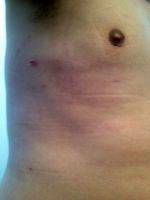Gynecomastia Divots
Gynecomastia surgery can be complicated by divots under the nipples. The two main causes are 1. an under resection of the surrounding gland/tissue or 2. over resection of behind the nipple.
Either one causes divots in almost any position.
Divots that become apparent in certain positions is likely due to adherence of the of the nipple to the under lying pecoralis fascia.
Fat grafting is the solution to the divot in this scenario as it will free the nipple from the underlying pectoralis and help fill in the divot. (Chad K. Wheeler, MD, Spokane Plastic Surgeon)
Indented areola after the correction of gynecomastia can be corrected
If your areola is indented, it means that you have less tissue behind your areola than you do behind the rest of your skin. First, you must wait for a few months after your surgery to make sure you are fully healed and are seeing the real result and not being fooled by swelling.

Crater Deformity After Gynecomastia Surgery
This could be fat injection or the placement of something like Alloderm. Most of our patients in New Jersey have a combination of liposuction and excision of gland tissue to fully correct their gynecomastia. It is important that these two procedures be done properly to leave behind the right amount of tissue under the skin and the nipple. (Parham Ganchi, PhD, MD, Wayne Plastic Surgeon)
I think the best option is a series of fat injections into the area, being done about 6 months apart to fill in the space between the skin and your pectoralis. Not all of the fat survives the first time, usually due to the scar tissue and that is why it usually needs to be repeated, but you will already look better after the first one heals. (Julio Garcia, MD, Las Vegas Plastic Surgeon)
This can be caused by too much tissue being removed from under the areola or not enough from the periphery of the chest or both. If there has been too much tissue removed, fat grafting is the solution. (Remus Repta, MD, Scottsdale Plastic Surgeon)
Raising Your Arms Is Not The Real Test
When the arms are raised the entire chest structures change. You must decide on the outcome of your gynecomastia with your hands by your side looking into a mirror. You also have scar tissue which alters how things appear.
If the crater appears with your arms down this is a issues and fat grafting or a fat fap can correct. (Miguel Delgado, MD, San Francisco Plastic Surgeon)
Crater Deformities Can be Improved
A “Crater Deformity” after gynecomastia surgery can usually be improved, although not always eliminated. It’s caused by a lack of adequate tissue beneath the nipple-areola. Fat injection to the crater done in one to three treatment sessions will usually work well. (George Sanders, MD, Los Angeles Plastic Surgeon)

Fat Flaps Are Performed By Separating The Skin Of The Chest From The Underlying Fatty Tissue
In a crater deformity, it can most often be corrected with a touch-up procedure where the surrounding excess fat is planed down to the crater level and/or some fat is grafted into that area to build it back up.
It is not unusual to need a touch-up in about 10-15% of cases. It is usually an outpatient and minimal down-time procedure. (Navin K. Singh, MD, Washington DC Plastic Surgeon)
Crater surface depression after gynecomastia resection
Aggressive removal of gland and fat tissues with gynecomastia resections can leave a depressed contour irregularity. Severe crater deformities can be improved with fat grafting, biological matrix implantation, and volume enhancement injections. Subcision may be required for dense scar that tethers the nipple to the underlying muscle fascia. (Randy Wong, MD, Honolulu Plastic Surgeon)

Gyno Crater Deformity
A depression around the nipple/areola region can occur during a male breast reduction (gynecomastia) if too much fat or breast tissue was removed during your procedure. I would recommend a fat transfer from another area (ex.abdomen) to fill in this defect. This can be done under local anesthesia with relatively minimal pain and downtime. You may need more than one session as some of the transferred fat may atrophy (shrink) and require further filling in the future. (William Bruno, MD, Beverly Hills Plastic Surgeon)
Fixing a sunken nipple after gynecomastia surgery
It’s important to leave a little nub of breast gland under the nipple so the nipple does not sink in or get scarred down to the pectoralis muscle. It sounds like your gland tissue was over-resected.
I would consider fat transfer to this area to plump it up and also provide some padding between the muscle and the nipple.Most men have some extra flank fat (love handles) that could serve as a donor site.
It may take more than one session of fat transfer but I think this would be the best approach. (Lisa Lynn Sowder, MD, Seattle Plastic Surgeon)
Contour problems after gynecomastia surgery can usually be fixed.
Over resection of the glandular tissue behind the areola and inadequate feathering of the fat peripheral to this can leave a thumb print of the areola. Treatment is to make the distribution of the tissue on the chest wall uniform.
Suction alone might work but direct excision might be necessary. (Vincent N. Zubowicz, MD, Atlanta Plastic Surgeon)
Crater deformity after liposuction can be fixed
After liposuction for the correction of gynecomastia, it is possible to have a depression or a crater deformity. This may be due to excessive liposuction in one area. In our practice, we have seen many patients who have had this deformity after having received liposuction at another facility.
We have helped these patients by doing a revision surgery that consists of ultrasound liposuction as well as regular liposuction and then fat grafting these deformities. (Pat Pazmino, MD, FACS, Miami Plastic Surgeon)
Crater deformity of chest
A crater deformity after gynecomastia surgery is very difficult to correct. Sometimes this can be corrected by autologous fat injections and may even be corrected wtih alloderm. (Steven Wallach, MD, New York Plastic Surgeon)
If your surgery was recently performed I would wait up to six months to allow all of the swelling to resolve and then reevaluate the area.
If this deformity still exists then fat graft would be a good treatment to improve the contour of the area. This may take several treatments. It is best to revisit with your surgeon so that he/she can monitor your progress and determine if this matter requires any intervention. (Earl Stephenson, Jr., MD, DDS, FACS, Atlanta Plastic Surgeon)
It is normal to have mild dimpling and inversion of the nipple following gynecomastia surgery or even in normal unoperated males. In rare circumstances, I have treated this problem with fat injections.
It typically takes 2 or 3 sessions and can be performed under local anesthesia if desire. On one other occasion I treated this with a dermal fat graft but this requires more invasive surgery with a donor site; it was “so successful” the patient requested removal. (Otto Joseph Placik, MD, Chicago Plastic Surgeon)
Crater deformity after gynecomastia is hard to fix
The infamous “crater” or “saucer” deformity after Gynecomastia surgery due to over resection of fat is hard to fix. But I am not so sure that that is exactly what you have. Classically, such deforming indentation is usually present at rest – yet you state “My nipple and area around it sinks in when I raise or flex my arm”.
That leads me to believe that your deformity, or at least a large part of it, is due to adherence of your “nipple and area around it” (?areola) to the underlying muscle. I think the nipple / areola complexes would need to be freed from the underlying muscle, fat should be infected in subcutaneous plane to even up any raised edges and you should be mobilized to prevent adherence again in this fashion.
If it works, the indentations should largely be gone. (Peter A. Aldea, MD, Memphis Plastic Surgeon)
Repairing a dent after gynecomastia surgery
If too much tissue is removed or if scar tissue develops between the pec muscle and the nipple, you will have contour irregularities. These are tough to fix but fat grafting to the indentation after releasing its tethering can help.
This may need to be repeated and may not totally correct the problem. (Richard P. Rand, MD, FACS, Seattle Plastic Surgeon)
Contour irregularities can be improved after aggressive gynecomastia surgery, but preventing these contour irregularities is the mainstay of therapy. Fat grafting and breast prostheses that are customized are long term solutions. (Raffy Karamanoukian, MD, FACS, Los Angeles Plastic Surgeon)
Structural fat grafting would improve the saucer deformity
Structural fat grafting using fat from another area would be your best bet. This may also require release of the tethering scar tissue at the same time which could be done using your original scar. (York Jay Yates, MD, Salt Lake City Plastic Surgeon)
Gynecomastia and Scarring
Gynecomastia requires removing the entire male breast gland. Some gentle liposuction at the edge of the removed gland will decrease the chance of cratering. In the recovery period, there is always stiffness and scarring underneath the skin and especially around the nipple area.
It does require several months for the firmness and scarring to soften up. The most important thing to do during your recovery is to massage the area, and the more aggressive the better. Most of the time the situation will resolve and rarely do you need a scar revision or fat grafting. (T.Y. Steven Ip, MD, FACS, New York Plastic Surgeon)
1. If you have a crater deformity when your arms are down or you are laying down then too much tissue was removed. The treatment for this is to add tissue, typically by harvesting fat from one area of your body and carefully injecting it into the deformity.
2. If you only have a crater deformity when raising your arms but not any other times, then you likely have scar tethering.This means that your areola is sticking down to your muscle via a scar. If massage does not help, then you would need surgery to release the scar. Regardless of the reason, I would wait at least 6 months before doing any further surgery. (Babak Dadvand, MD, Los Angeles Plastic Surgeon)

